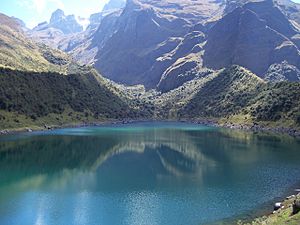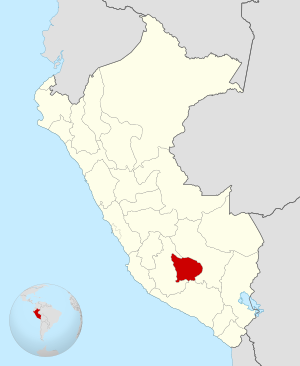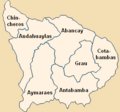Department of Apurímac facts for kids
Quick facts for kids
Department of Apurímac
|
|||
|---|---|---|---|

The lake Usphaqucha with the volcano Ampay in the background
|
|||
|
|||

Location of the Apurímac region in Peru
|
|||
| Country | Peru | ||
| Subdivisions | 7 provinces and 80 districts | ||
| Capital | Abancay | ||
| Area | |||
| • Total | 20,895.79 km2 (8,067.91 sq mi) | ||
| Highest elevation | 3,952 m (12,966 ft) | ||
| Lowest elevation | 2,378 m (7,802 ft) | ||
| Population
(2017)
|
|||
| • Total | 405,759 | ||
| • Density | 19.418218/km2 (50.29295/sq mi) | ||
| UBIGEO |
03
|
||
| Dialing code | 083 | ||
| ISO 3166 code | PE-APU | ||
| Principal resources | Fruit, maize, potato, wheat, eucalyptus. | ||
| Percentage of Peru's GDP | 0.42% | ||
| Website | www.regionapurimac.gob.pe | ||
Apurímac is a region in southern-central Peru. It shares borders with the Cusco Region to the east and the Ayacucho Region to the west. To the south, it borders the Arequipa Region and Ayacucho Region. The name Apurímac comes from the Quechua language. It means "where the gods speak." This refers to the many mountains in the region, which people in the Andean religion saw as gods talking to each other.
Contents
Exploring Apurímac's Divisions
Apurímac is divided into 7 main areas called provinces. These provinces are then split into 80 smaller areas called districts. Each province has its own capital city.
- Abancay (Capital: Abancay)
- Andahuaylas (Capital: Andahuaylas)
- Antabamba (Capital: Antabamba)
- Aymaraes (Capital: Chalhuanca)
- Chincheros (Capital: Chincheros)
- Cotabambas (Capital: Tambobamba)
- Grau (Capital: Chuquibambilla)
People and Culture in Apurímac
This section tells us about the people living in Apurímac. It covers the languages they speak, their backgrounds, and their beliefs.
Languages Spoken in Apurímac
Most people in Apurímac speak Quechua as their first language. About 70% of residents speak Quechua. The other main language is Spanish, spoken by about 29% of the people. In Apurímac, you'll hear different types of Quechua, like Cusco Quechua and Chanka Quechua.
| Province | Quechua | Aymara | Asháninka | Another native language | Spanish | Foreign language | Deaf or mute | Total |
|---|---|---|---|---|---|---|---|---|
| Abancay | 43,425 | 189 | 15 | 32 | 46,510 | 41 | 152 | 90,364 |
| Andahuaylas | 98,774 | 249 | 25 | 22 | 35,043 | 12 | 190 | 134,315 |
| Antabamba | 8,771 | 32 | 3 | 9 | 2,532 | 6 | 20 | 11,373 |
| Aymaraes | 19,754 | 42 | 4 | 3 | 7,953 | 1 | 44 | 27,801 |
| Cotabambas | 38,091 | 70 | 7 | 9 | 4,034 | 2 | 28 | 42,241 |
| Chincheros | 38,563 | 67 | 8 | 6 | 9,154 | 1 | 160 | 47,959 |
| Grau | 18,958 | 52 | 2 | 12 | 4,239 | 6 | 55 | 23,324 |
| Total | 266,336 | 701 | 64 | 93 | 109,465 | 69 | 649 | 377,377 |
| % | 70.58 | 0.19 | 0.02 | 0.02 | 29.01 | 0.02 | 0.17 | 100.00 |
Who Lives in Apurímac?
Most people in Apurímac identify as Quechua. This group makes up over 85% of the population. Other groups include Mestizo (people of mixed European and Indigenous ancestry) and smaller numbers of White-Peruvians, Aymara, and Afro-Peruvians.
| Ethnicity | Percentage | Number |
|---|---|---|
| Quechua | 85.7% | 277,624 |
| Mestizo | 9.9% | 32,152 |
| Other | 2.8% | 9,069 |
| White-Peruvian | 1% | 3,127 |
| Aymara | 0.3% | 997 |
| Afro-Peruvian | 0.3% | 820 |
Religious Beliefs
The majority of people in Apurímac are Catholic, making up almost 80% of the population. About 17% are Evangelical Christians. A smaller number of people follow other religions or have no religious beliefs.
| Religion | Percentage | Number |
|---|---|---|
| Catholicism | 77.9% | 256,430 |
| Evangelical | 17.7% | 58,404 |
| Other | 2.4% | 7,798 |
| Irreligious | 2% | 6,525 |
Education and Literacy
A large part of the population in Apurímac can read and write. About 80% of the people are literate. This means they have learned to read and write.
A Glimpse into Apurímac's Past
Not much is known about the very first people in Apurímac. However, old stories say that the first settlers were tribes from the Quechua and Aymara groups. The Chancas, a group of brave warriors, settled in the Andahuaylas area. They were known for being rebellious and fearless.
Stories tell that the Chancas spent years preparing to conquer the great city of Cusco. But thanks to the clever plans of Inca Pachacutec, the Inca Empire was saved.
When the Spanish conquerors arrived, most of Apurímac was part of the Huamanga area. However, there are not many records about new cities being built during that time.
Later, when Peru became a republic, Abancay was part of Cusco. On April 28, 1873, a law was passed to create the Department of Apurímac. It included provinces like Andahuaylas, Antabamba, Aymaraes, and Cotabambas. Abancay was chosen as its capital.
Cool Places to Visit in Apurímac
Apurímac has many interesting places to explore, from bustling cities to quiet natural spots.
Cities and Towns to See
- Abancay is the capital city. It's the most important place for business and government in the region.
- Andahuaylas is a cooler city, located high up at 2,980 meters (about 9,800 feet) above sea level. It's a center for farming. Its main church is the Cathedral de San Pedro, built in an old Colonial style. The main square has a unique stone fountain.
- Near Abancay, on the way to Cusco, you can find the famous Saywite Stone. This large stone has many carvings that puzzle experts.
- Talavera de la Reyna is a town about 4 kilometers (2.5 miles) from Andahuaylas. Its main square is made of stone and has an impressive clock tower. You can also visit the warm baths of Hualalache nearby.
- Chalhuanca is the capital of Aymaraes province. It's at 2,800 meters (about 9,200 feet) and has beautiful old churches from Colonial times. These churches have amazing wood carvings and gold leaf decorations.
Ancient Discoveries in Antabamba
In Antabamba, scientists have found ancient human skulls with very precise trepanations (a type of surgery where a hole is drilled into the skull). They also found old mud sculptures, weapons, and tools used for daily life and hunting.
Relaxing at Paqucha Lake
Paqucha Lake is considered one of Peru's largest and most beautiful lakes. It's located at 3,000 meters (about 9,800 feet) between Andahuaylas and Abancay. It's a great spot to relax and enjoy nature. You can even go fishing and duck hunting there.
Local Traditions and Fun in Apurímac
Apurímac is rich in traditions, from unique dishes to lively festivals.
Delicious Local Food
A special dish in Apurímac is the wathiya. This ancient dish is made by cooking potatoes on hot stones surrounded by a fire. People used to make it during planting and harvesting times.
Another popular dish is potatoes and eggs with uchullaqwa. This is a sauce made from chili, cottage cheese, and Tagetes minuta, a herb known as wakatay in Peru. For bread lovers, there are many types like rejillas, tarapacos, paltos, and roscas.
Exciting Festivals and Celebrations
Apurímac has many colorful festivals throughout the year:
- January 1 to 6: New Year's celebrations in Andahuaylas. The Baja de Negros (dancers dressed as black men) is a highlight. There's lots of music and dancing.
- February: Carnivals are a big deal! The whole town joins La Yunsa, a lively street party. In Andahuaylas, people dance day and night. In Grau, bullfights are held, and a special event called torril velacuy happens the day before to keep bad spirits away. In Aymaraes, there's a sling tournament between different districts, which can be quite intense.
- May 13: The Fiesta de la Virgen de Fátima in Grau. It's a huge display of local music and dance.
- June 24: A Farm Products and Livestock Fair in Pachaconas (Antabamba). Farmers show off their best products.
- July 28: Yawar Fiesta ("blood festival") in Andahuaylas. This is a special bullfight where a condor is tied to the bull's back. The condor tries to free itself, sometimes hurting the bull. After the event, the condor is released. There are also cockfights and a traditional trip to Paqucha Lake for trout fishing.
- August 15: Fiesta de la Virgen de la Asunción in Grau. People join processions and prayers. Cattle branding, called tinka, also takes place. In Cotabambas, this day also features the Yawar Fiesta.
- September 8: Fiesta de Nuestra Señora de Cocharcas. This is a very important religious celebration in Apurímac and all of Peru.
- September 24: Fiesta de Nuestra Señora de las Mercedes in Antabamba. Everyone is invited to dance, eat, drink, and watch bullfights and horse races.
- October 7: Fiesta de la Virgen del Rosario in Abancay. There are processions and fireworks.
- November 3: This day celebrates the anniversary of Abancay city. There are sports, cultural events, parties, cockfights, and bullfights.
- December 8: Fiesta de la Virgen de la Concepción in Cotabambas. People dance in the main square for several nights.
- December 25: During Christmas Eve and Christmas, people in Cotabambas dance in the streets with costumed dancers. Crowds sing and pray to the Holy Child. There are also processions, fireworks, and big meals with traditional food.
Famous People from Apurímac
Apurímac has been home to several notable individuals who have made a mark in literature and arts.
- Juan Espinoza Medrano: An important writer and priest from Calcauso, Antabamba.
- José María Arguedas: A famous poet, novelist, and anthropologist born in Andahuaylas. He wrote well-known books like Los Rios Profundos and Todas las Sangres.
- Fredy Roncalla: A poet, essayist, and jewelry maker from Chalhuanca.
- María Isabel Granda y Larco, known as Chabuca Granda: A celebrated Peruvian singer and songwriter, born in Progreso, Grau.
See also

- Ampay National Sanctuary
Images for kids





